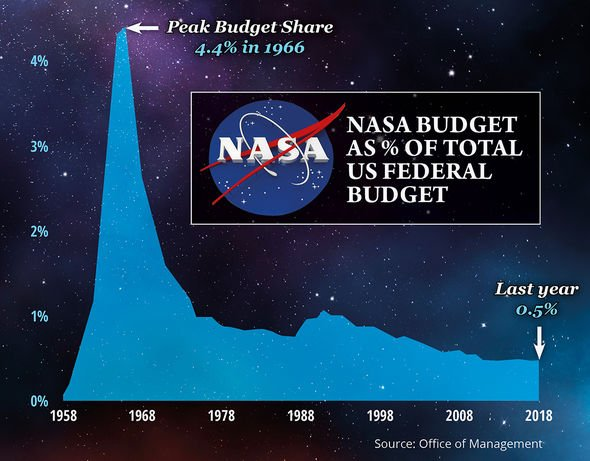NASA Budget Cuts: Trump’s $6 Billion Reduction Explained

In a significant shift for America’s space exploration, recent NASA budget cuts proposed by the Trump administration could slash around $6 billion from the agency’s total funding. Despite this extensive reduction, a notable $1 billion has been earmarked for ambitious Mars-focused initiatives that align with the goals of Elon Musk and SpaceX. This reallocation is indicative of a broader strategy to accelerate the U.S. return to the Moon and achieve triumphant human landings on Mars, intensifying competition with China in space. As NASA gears up to streamline operations and make difficult decisions regarding ongoing projects, it also emphasizes the importance of resilience among its workforce. With NASA mission updates indicating a leaner future, the spotlight remains on how these drastic changes will impact long-standing scientific endeavors, underscoring the delicate balance between fiscal responsibility and ambitious exploration.
Recent financial reforms impacting the National Aeronautics and Space Administration (NASA) have sparked debates about the future of U.S. space missions. The administration’s initiatives, reminiscent of bold plans for space exploration and interplanetary endeavors, have led to a considerable budget realignment. They aim to prioritize certain missions, particularly those centered on Mars, while prompting the agency to reevaluate its priorities and workforce capabilities. With the spotlight on space travel ambitions, these funding alterations could define the trajectory for American leadership in the next era of space exploration, akin to initiatives pursued by commercial space ventures such as those led by visionary entrepreneurs and industry leaders. As we delve deeper into the implications of these budgetary changes, the conversation inevitably leads to critical questions about the sustainability of space science and the continuation of transformative missions.
Impact of NASA Budget Cuts on Space Exploration
The proposed cuts to NASA’s budget signal a significant shift in priorities for the agency, concentrating around ambitious missions to Mars. With a proposed reduction of $6 billion, NASA is not only facing a major decrease in funding but is also required to make difficult decisions about its workforce and ongoing projects. This move could jeopardize critical scientific research and infrastructure that supports ongoing space exploration efforts. The budget cuts, alongside the push to enable moon landings, highlight a strategic focus to reclaim leadership in space exploration amidst growing competition from international players like China.
In addition to the cuts, NASA is expected to phase out essential programs like the Space Launch System (SLS) and the Orion spacecraft, which have been integral to previous and future missions. This raises concerns among scientists and engineers about the long-term implications for missions designed to study distant worlds and understand life beyond Earth. As Janet Petro indicated, these budgetary constraints demand resilience and adaptability among the workforce, but the cost may lead to delays in mission updates and a narrow focus on Mars-centric initiatives sanctioned by the administration.
Elon Musk and SpaceX’s Role in Future Martian Missions
Elon Musk’s SpaceX is poised to play a pivotal role in NASA’s revised focus on Mars missions, thanks to its innovative technology and ambitious vision for human space exploration. Musk’s company aims to utilize the Starship rocket for crewed missions to the Red Planet, an undertaking that aligns with the Trump administration’s objective of advancing space exploration in the face of budget constraints. With $1 billion allocated to Mars-centric programs, NASA’s partnership with SpaceX could enhance the possibilities of achieving groundbreaking milestones such as the first human landings on Mars.
The collaboration between NASA and SpaceX is not just about launching missions; it reflects a broader strategy to tap into private sector capabilities, ensuring that the U.S. maintains its competitive edge in space. Musk’s previous statements about sending humans to Mars by 2026, despite being met with skepticism, illustrate the aggressive timeline he promotes. This dynamic places both organizations at a critical juncture, where they must innovate quickly to deliver on ambitious goals while also managing fiscal limitations imposed by NASA’s funding reduction.
Reallocating NASA’s Budget: The Funding Focus Shift
As the Trump administration reallocates NASA’s budget away from various scientific missions towards a Mars-centric approach, the agency must confront the realities of these fiscal decisions. The shift away from traditional funding streams for Earth science and space science projects could stifle significant research that enhances our understanding of climate change and other vital issues. The strategic pivot, while aiming to boost moon exploration and Mars missions, might overshadow the critical need to address ongoing scientific studies that contribute to Earth’s well-being and technological advancements.
Moreover, the announcement about redirecting approximately $1 billion toward Mars-oriented initiatives raises questions about the future of numerous established projects at NASA. The administration’s support implies a prioritization of human exploration of Mars over fundamental research endeavors, risking the cancellation of programs that have previously yielded valuable scientific insights. This funding focus necessitates a careful balance, ensuring that while ambitious goals are pursued, vital research that may influence future generations is not overlooked.
Challenges Facing NASA in the New Budget Era
The forthcoming cuts pose significant challenges for NASA as it navigates an evolving landscape of federal funding. With a potential 25% reduction marked, employees are preparing for tough choices regarding which missions may no longer be viable. Janet Petro’s emphasis on ‘streamlining’ signifies the intent to create a more agile organization, but this need for efficiency could detract from NASA’s ambitious scientific objectives. Inevitably, this situation raises concerns about how budget cuts will impact personnel, mission timelines, and future technology development.
Furthermore, NASA’s ability to execute its long-term vision might be hindered by financial restrictions, compounded by the need for strategic partnerships with private aerospace firms such as SpaceX and Boeing. With reduced funding for projects like the Mars Sample Return Program, NASA may have to rely increasingly on collaborative ventures to fill gaps left by budgetary cuts. As pressure mounts to deliver on lunar and Martian objectives under the new fiscal regime, the agency’s adaptability will be tested in unprecedented ways.
The Role of Public and Private Partnerships in NASA’s Future
In an environment of significant budget cuts, public-private partnerships become increasingly essential for NASA’s mission success. Collaborations with private companies, particularly SpaceX, can help leverage investment and innovation necessary for achieving ambitious goals like manned Mars exploration. The push towards utilizing commercial entities signifies a shift in how NASA approaches its missions, aiming to combine limited federal resources with private sector efficiencies and contributions.
Such partnerships could pave the way for new technologies and solutions that may not be attainable under traditional funding structures. The rise of entrepreneurship in space exploration also opens doors to diverse approaches and ideas, which may streamline NASA’s processes while fostering a competitive environment among contractors. As NASA navigates the implications of budget cuts, strengthening relationships with private organizations remains a vital strategy to enhance its capabilities and meet its exploratory goals.
NASA’s Search for Efficiency Amid Funding Reductions
In response to the Trump administration’s proposed budget cuts, NASA is on a mission to become more efficient with its resources. This newfound emphasis on efficiency comes as the agency has committed to aligning its goals with Mars-centric missions while simultaneously managing significant financial constraints. Streamlining operations means prioritizing certain projects, but it may also result in the termination of long-standing initiatives that have enjoyed substantial investment over the years.
Finding a balance between maintaining scientific integrity and pursuing efficiency becomes paramount for NASA. The agency must navigate tough choices, ensuring that essential research and development are not sacrificed for the sake of immediate cost savings. As suggested by Janet Petro’s initiatives, a careful examination of programs and projects is crucial to determine which can be put on hold or phased out, all whilst remaining focused on future advancements in human space exploration.
Navigating the Political Landscape of NASA Funding
NASA’s budget cuts are not merely financial; they reflect the broader political landscape regarding space exploration in the United States. The decisions made by the Trump administration carry significant implications for national priorities in science, technology, and public spending. The choice to support Mars missions while slashing funds for existing programs illustrates a shift in focus that may have long-lasting effects on the scientific community’s ability to conduct research and develop technologies essential for future space endeavors.
While political motivations influence funding decisions, it’s crucial for NASA to proactively communicate the necessity of comprehensive funding for research. Advocates for space science may need to rally support from both political circles and the public to highlight the importance of a well-rounded space exploration agenda. Addressing space interests holistically can ensure that NASA remains at the forefront of exploration, fulfilling not only its immediate goals but also its broader mission to enhance humanity’s understanding of the cosmos.
Future Prospects for NASA Under New Leadership
The anticipated leadership of Jared Isaacman at NASA carries with it a range of expectations regarding the agency’s future, especially in the context of the proposed funding cuts. Known for his entrepreneurial spirit and accomplishments in private space travel, Isaacman represents a new approach that may emphasize innovation and adaptability within the constraints of reduced financial support. His leadership might also foster a stronger relationship between NASA and private enterprises like SpaceX, which is already revolutionizing space transportation.
As the Senate deliberates on Isaacman’s candidacy, observers are eager to see how his tenure could shift NASA’s strategic vision amid funding reductions. His unique perspective could lead to exploring alternative funding mechanisms or partnerships to sustain ambitious projects while adhering to the agency’s budget. The hope is that this new leadership will successfully navigate both the fiscal challenges and the aspirational goals set for the agency, ensuring that NASA continues to inspire and innovate in the realm of space exploration.
Public Reactions to NASA Budget Changes and Future Missions
The public’s response to NASA’s budget cuts and the subsequent focus on Mars missions has been a mix of skepticism and hope. Many space enthusiasts and scientists sound alarms about the diminishing of essential scientific programs, fearing that cutting research budgets can undermine critical areas of study. Conversely, supporters of Mars exploration view the increased funding for such initiatives as a vital step towards realizing dreams of interplanetary colonization and scientific discovery beyond Earth.
With increased visibility on SpaceX’s role in potential Mars missions, the excitement generated by high-profile space projects often overshadows concerns about reduced funding for more traditional NASA activities. The public discourse around space exploration has grown more complex, with voices advocating for both continued scientific research on Earth and innovative advances out in space. As NASA endeavors to forge ahead with its ambitious objectives, managing public sentiment will be key in securing broader support for the agency’s long-term goals.
Frequently Asked Questions
What are the implications of the Trump NASA budget cuts for future Mars missions?
The Trump NASA budget cuts have proposed a $6 billion reduction in funding, with reallocations aiming at Mars-focused missions. While this emphasizes a push towards sending humans to Mars, it also signifies potential termination of other scientific projects. NASA’s acting administrator noted that the budget aims to prioritize critical missions like Mars while making tough choices affecting many current programs.
How will NASA funding reduction affect the SpaceX Mars mission plans?
The proposed NASA funding reduction under the Trump administration focuses on directing resources towards Mars missions, potentially benefiting SpaceX’s goal of a manned mission to Mars. However, NASA’s cuts could affect collaborations and support for various projects reliant on its budget, putting additional pressure on SpaceX to achieve Mars goals independently.
What NASA mission updates can we expect following the budget cuts?
With NASA facing budget cuts of up to 25%, mission updates are expected to reflect a more streamlined approach. This includes phasing out certain programs such as the Space Launch System and Mars Sample Return missions, allowing NASA to concentrate on initiatives directly aligned with the administration’s goal of Mars exploration and lunar missions.
What challenges will NASA face due to budget reductions related to the Trump administration’s plans?
NASA will face significant challenges due to the proposed budget reductions, including workforce streamlining and the potential termination of multiple scientific initiatives. As NASA transitions to a more limited budget, staff morale and the ability to execute current missions may be impacted, prompting the organization to adapt to a new fiscal reality.
How does Elon Musk’s vision align with the Trump NASA budget proposals?
Elon Musk’s vision for Mars exploration aligns closely with the Trump NASA budget proposals, which dedicate substantial resources toward Mars missions. Musk’s advocacy for space exploration complements the administration’s strategy of reinforcing America’s leadership in space, although NASA’s budget cuts could hinder collaborative efforts and necessitate adjustments in project timelines.
What will the $1 billion allocated for Mars programs involve under the new NASA budget?
The $1 billion earmarked for Mars programs is intended to bolster efforts in human exploration and technology development for Mars. This allocation focuses on advancing capabilities needed for Mars missions, despite the overall reduction in NASA’s budget, indicating a strategic prioritization of missions that can accomplish long-term goals in space.
Are there any specific NASA programs scheduled for termination due to budget cuts?
Yes, several NASA programs are facing termination due to budget cuts, including the Space Launch System (SLS) rocket, Orion spacecraft, and Mars Sample Return program. These terminations reflect the administration’s focus on fiscal responsibility while redirecting resources towards prioritized initiatives like Mars exploration.
| Key Point | Details |
|---|---|
| Budget Cut Amount | $6 billion reduction in NASA’s budget, affecting various programs. |
| Funding Shift | $1 billion reallocated towards Mars-focused missions. |
| Administrator’s Message | Janet Petro calls for perseverance and resilience amid budget cuts and difficult choices. |
| Moon Exploration Funding | Over $7 billion allocated for moon exploration programs. |
| Impacted Programs | Phasing out the SLS rocket, Orion spacecraft, and Gateway programs along with scientific initiatives. |
| SpaceX’s Role | SpaceX aims for a manned Mars mission and is a significant contractor for NASA. |
| Long-term Implications | Potential reductions in NASA’s space science and mission support divisions, impacting various contracts. |
Summary
NASA budget cuts have been proposed by the Trump administration, aiming to reduce funding significantly while reallocating resources towards Mars missions. As NASA navigates through these budget adjustments, the implications could reshape the agency’s long-term goals and mission focus, emphasizing the need for resilience and strategic planning as they pivot towards critical initiatives in space exploration.




